mievent
Navigating the Business of Ophthalmology
The recent Australian Society of Ophthalmologists (ASO) Skills Expo brought together medical professionals, business experts, and thought leaders, to explore how to thrive in an evolving healthcare landscape.
WRITERS Dr Mariana Sheales and Dr Eve Hsing
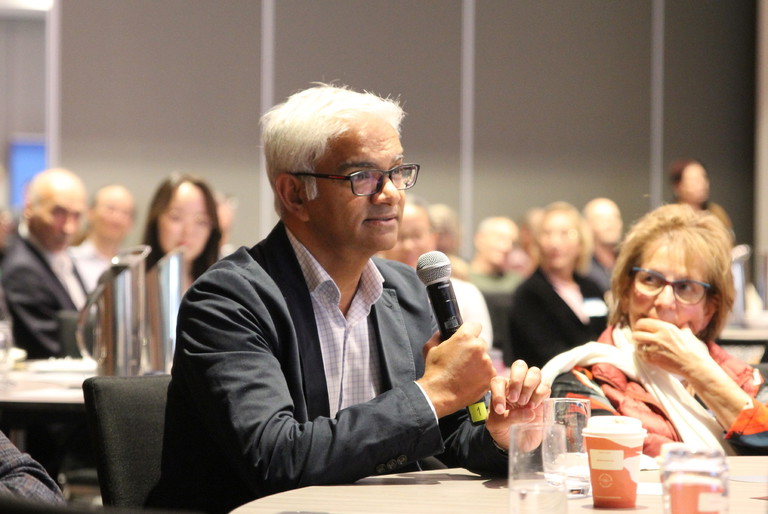
Dr Shish Lal, ASO Board Director NSW.
The intensive two-day 10th ASO Skills Expo, held at the Westin Brisbane, focussed on the business more than the clinical aspects of ophthalmology, with wide-ranging topics of discussion including practice structures, financial planning, human resources, taxation, and the strategic use of medical real estate.
Attendees also gained valuable insights into the role of artificial intelligence, refractive lens surgery, and sector-wide challenges affecting private practice. A strong emphasis on professional development and technological innovation highlighted the ASO’s commitment to equipping ophthalmologists with the skills to succeed in a changing healthcare environment.
Opening the conference, held from 31 May to 1 June, co-Convenor Dr Bill Glasson made special mention of former CEO Kerry Gallagher, who retired after 16 years of service, and his successor Katrina Ronne. Associate Professor Kristopher Rallah-Baker (Queensland), Australia’s first Indigenous ophthalmologist, provided the Welcome to Country, setting the tone for a day of shared learning in the ‘business of ophthalmology’.
FOUNDATIONS FOR A SUCCESSFUL PRACTICE
Foundations for a successful practice was presented by Jarrod Bramble, Managing Partner of the accounting and financial firm, Cutcher and Neale. Mr Bramble discussed types of practice structures, including trusts, companies, and self-managed super funds. Discussion centred around how best to share profit between owners in a way that could be considered to be fair, as well as what service fees are typical for ophthalmology practices. Lastly, he said it is important to have a succession plan, and to maximise your super contributions.
PRIVATE PRACTICE IN CRISIS?
In the Dr Andrew Stewart Lecture titled ‘Are private doctors going out of fashion?’, Associate Professor Julian Rait OAM – ASO member and Vice President of the Australian Medical Association (AMA) – described the evolution and current challenges facing Australia’s private medical sector. He traced the origins of Australia’s healthcare system, from the proposed National Health Insurance Scheme of the 1930s to the eventual establishment of Medibank (now Medicare) in 1972, highlighting growing tensions between the government and the medical profession over time.
Prof Rait outlined recent developments such as Urgent Care Clinics (UCCs), noting their high costs, lack of continuity of care, and their negative impact on existing general practitioner (GP) services. He raised concerns over role substitution initiatives, such as pharmacists taking on diagnostic and prescribing roles, which could compromise patient safety. However, he welcomed the government’s move to expand GP training positions as a positive step.
Growing threats to private practice were also outlined, including the dominance of private health insurers, underpayment to hospitals, reduced clinical autonomy, delayed claims, and selective procedure coverage. Drawing parallels with the United States, where most doctors are now employed by corporations, he highlighted profit-driven care models compromising quality.
Prof Rait advocated for an independent authority to regulate Australia’s private health system and reaffirmed the AMA’s role in safeguarding the future of the profession.
PRACTICE GROWTH
Dr Brad Horsburgh (Queensland) introduced delegates to the useful (and free) ASO Practice Growth Calculator, which he designed. It can be accessed via the ASO website in the members’ hub. This interactive tool allows you to input your own data regarding consultation and procedure volume with associated fees. It then gives an estimate of revenue and expenses for the current and following financial year.
NAVIGATING MEDICAL REAL ESTATE
The session on medical real estate discussed aspects of strategic site selection, ownership, and leasing. It is important to perform market research when planning the location as well as determining the type of building that best suits your needs. It may be advantageous to initially lease as it is cheaper, and easier to move if expansion is required. Building ownership can also occur through a selfmanaged superannuation fund. This can be a good investment due to limited availability of suitable sites and is a reliable source of income due to its essential nature.
FINANCIAL REALITIES
Adele Creighton, Director of Healthcare at Macquarie Bank, outlined five key themes in the healthcare industry: moderate growth below pre-COVID levels, payroll tax and margin pressures, challenges in attracting and retaining staff, underutilisation of day hospitals, and an ongoing focus on improving operational efficiency across the sector.
Nicole Brown, Partner at Cutcher and Neale, outlined the seven pillars for building wealth: cashflow, income and tax minimisation, estate planning, key performance indicators, superannuation, insurance, and cloud systems. Ms Brown shared some practical strategies for reducing tax, including end-offinancial-year planning and key deductions relevant to medical professionals, such as negative gearing, bucket companies, and super contributions. She concluded by outlining the financial attributes commonly seen in a successful, financially secure medical professional.
HUMAN RESOURCES: COMPLIANCE AND COST CONTROL
The session on payroll compliance was presented by George Sotiris from HR in Health. Wages are known to be the biggest expense in medical practices and therefore it is important to ensure they are handled correctly. It is vital to know what each staff contract says with regards to the award rate level of pay and associated conditions. Overtime can also be costly and unpredictable, therefore ‘true’ overtime and the approval process should be clearly defined. Importantly, as of 1 July 2025, minimum award wages and super guarantees have increased.
“Discussion centred around how best to share profit between owners in a way that could be considered to be fair, as well as what service fees are typical”
MEDICAL INNOVATION ON THE HORIZON
The discussion on new and future technology was presented by representatives from Alcon, Bausch and Lomb, Glaukos, and Johnson and Johnson. Delegates heard about current research and development projects across multiple subspecialties. This included improved microscope performance, extended depth of focus lenses, direct selective laser trabeculoplasty, and a new drug eluting stent for glaucoma.
Dr Jamie Chew, co-founder of iScribe, provided a live demonstration of an Australian artificial intelligence (AI) scribe tool in action by simulating a patient consultation with the help of Expo co-Convenor Dr Louise Robinson. The software effectively summarised, in realtime, each aspect of the medical history, examination findings, and counselling points, and generated reports and patient-friendly summaries. Dr Chew highlighted the time-saving benefits and the opportunity to enhance quality of care, trust, and communication with patients and colleagues. He emphasised that AI scribes are administrative aids and their potential lies in improving documentation efficiency. However, “clinicians must remain mindful that they are responsible for verifying the accuracy and finalising records”, he said.
Matthew Montgomery, Case Manager for MDA National – a medico-legal advisory company – outlined key medicolegal risks associated with AI use in medicine, particularly AI scribe software that uses both generative and predictive AI. He highlighted concerns around patient consent, privacy, security of data storage, and data ownership, noting legal variations across various jurisdictions within Australia. It was concluded that although AI tools can assist clinical practice, they do not replace the doctor’s legal obligations.
Both Dr Chew and Mr Montgomery explored some practical strategies for obtaining informed patient consent when implementing AI scribes in private practice, including timely documentation of consent at each visit.
Dr Chew also reiterated the importance of specifying a clear diagnosis and treatment plan to maximise output accuracy by the AI software.
REFRACTIVE LENS EXCHANGE: A GROWING MARKET
The ophthalmic industry session focussed on the business of refractive lens exchange and was presented by Dr Justin Sherwin (Victoria). This is a growing area of private practice with an increased number of patients looking for glasses’ independence. There is an important financial difference compared to cataract surgery, as patients need to fund the procedure entirely. Medicare and private health funds do not provide a rebate.
Ideal patients include those who have good ocular health, who are presbyopic, lowmoderate hyperopes, or those with narrow angles. Patient education and counselling is vital to ensure realistic expectations, and bilateral sequential surgery is often considered.
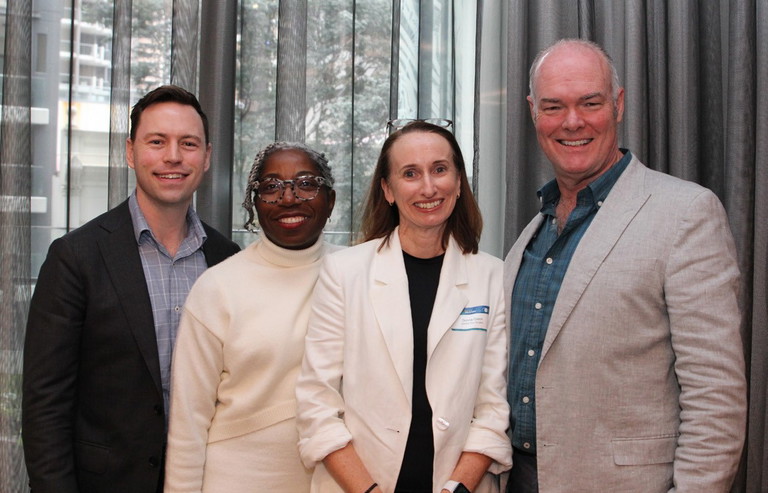
From left: Dr Tim Beckman, Peggy Ekeledo-Smith, Donna Glenn, and Dr Brad Horsburgh.
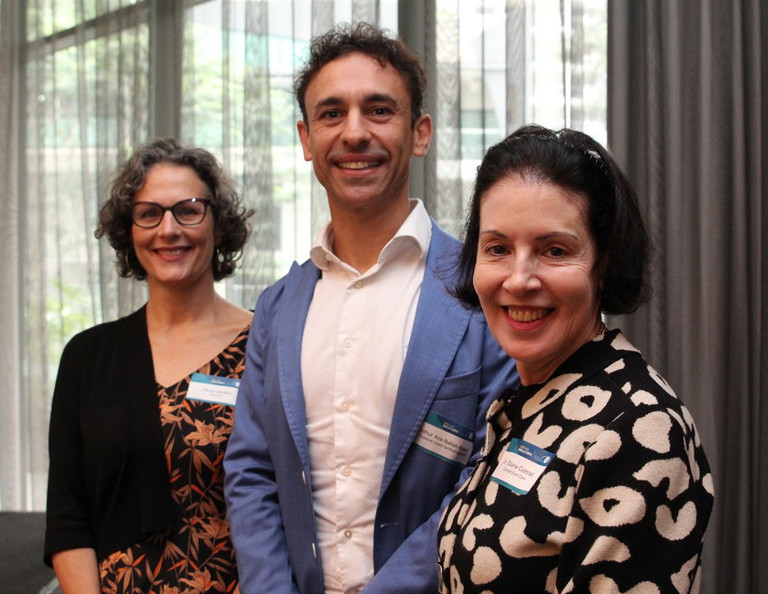
From left: ANZEF Head of Foundation Paula Llavallol, Assoc Prof Kris RallahBaker, and RANZCO Vice President. Dr Diana Conrad.
RANZCO AND ANZEF: UPDATES, GRANTS, AND VISION FOR THE FUTURE
The Royal Australian and New Zealand College of Ophthalmologists (RANZCO) provided an update on key issues, including optometrists’ increasing scope of practice, new more rigid continuing professional development requirements, issues around ongoing medication, and equipment shortages. Most of the discussion, however, was based around a proposed specialist international medical graduate pathway. The new pathway would bypass the current system where RANZCO assesses applicants. Instead, the Australian Medical Council (AMC) would accredit applicants if trained in a country with comparable training.
The Australian and New Zealand Eye Foundation (ANZEF) provided an update of its current activities. The ANZEF provides grants of up to AU$50,000 for projects to assist organisations or professionals working in eye-related fields. These grants can be used for health promotional activities, education, research, and improving access to care, particularly for those in Indigenous communities but also South Pacific Islands. One project aims to increase the number of Indigenous ophthalmologists. ANZEF is helping to cover the cost of the RANZCO training programme application, as well as providing scholarships of $30,000 towards training costs.
“Dr Chew and Mr Montgomery explored some practical strategies for obtaining informed patient consent when implementing AI scribes in private practice”
DEFINING SUCCESS FROM EARLY CAREER TO RETIREMENT
The Expo concluded with discussion about what success looks like by two ophthalmologists at opposite ends of their working careers. Dr Darryl Gregor and Dr Matthew Cranstoun (both from Queensland) noted the challenges of working in private practice as ophthalmologists do not receive training in business management. Thus, it is important to find mentors in business to help shape a successful practice. Important take away points were: remember to have a good worklife balance, find things you enjoy outside of medicine, have things to look forward to, learn how to deal with setbacks, and be innovative.
NETWORKING OPPORTUNITIES
The exhibition hall provided a great space to reconnect with friends and colleagues between lectures, with the opportunity to engage with the 14 exhibitors in attendance. The relaxed atmosphere lent itself to plenty of interactions between attendees and with trade show partners.
Exhibitors included industry representatives showcasing the latest technology and pharmaceuticals, and financial institutions, Mater Education, Vanguard Health, and pharmacy providers speaking about available services.
Dr Mariana Sheales MB BS MPH MMed (Ophth Sc) FRANZCO is an ophthalmologist with Clarity Eye Surgeons in Canberra.
Dr Eve Hsing MBBS FRANZCO is an ophthalmologist practising at Okko Eye Specialist Centre and Valley Eye Specialists in Brisbane.
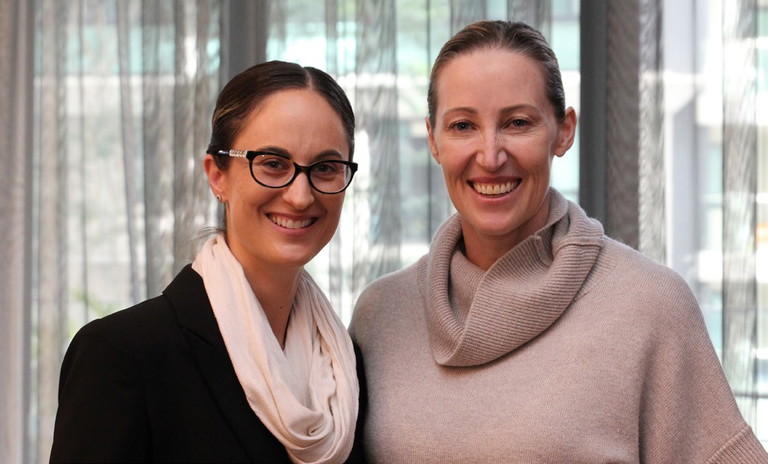
Dr Mariana Sheales with Dr Jana Pittman who delivered a keynote on leadership and overcoming fear.
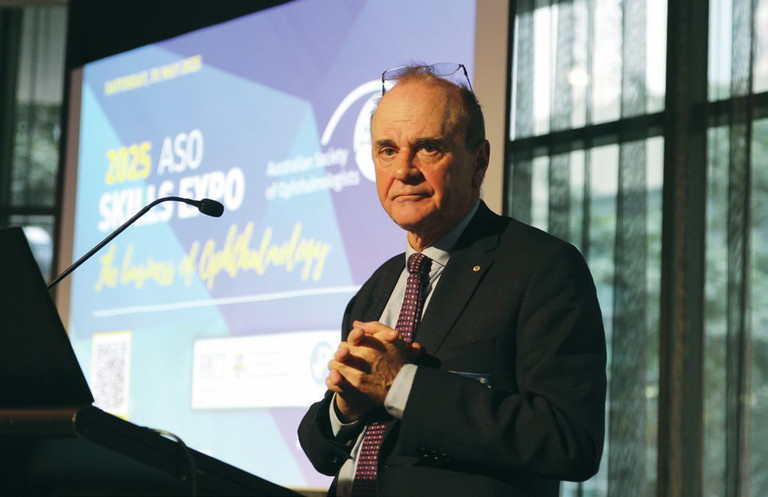
Assoc Prof Julian Rait AO delivering the Dr Andrew Stewart Lecture.
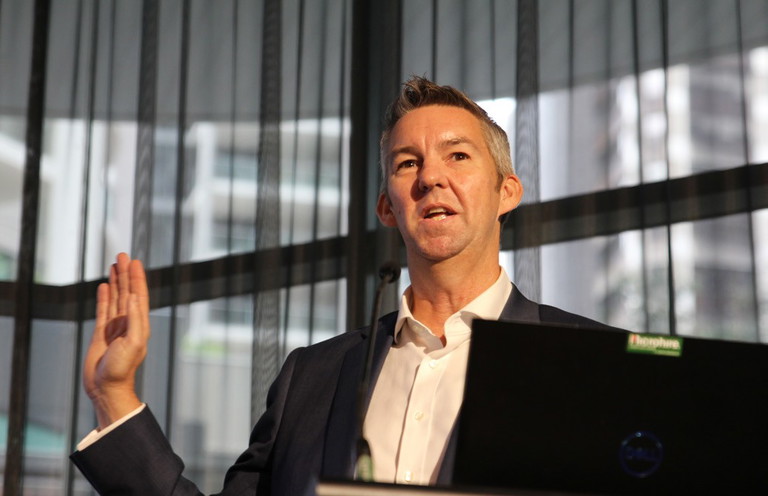
Jarrod Bramble from Cutcher and Neale.
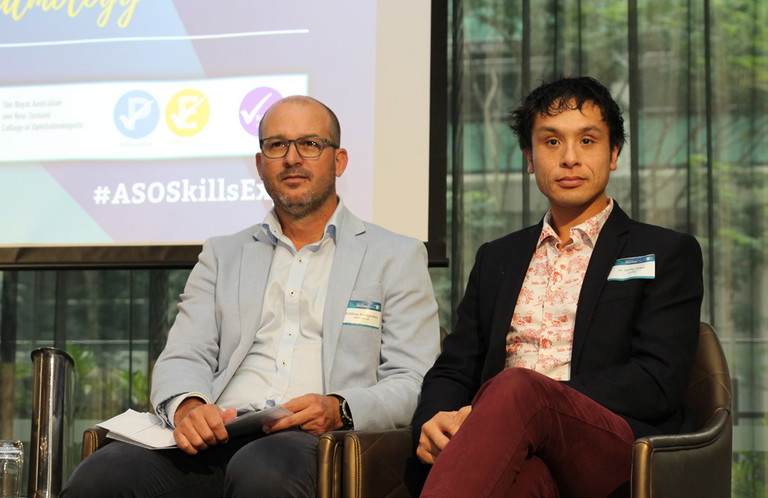
Matthew Montgomery from MDA National and Dr Jamie Chew from iScribe.